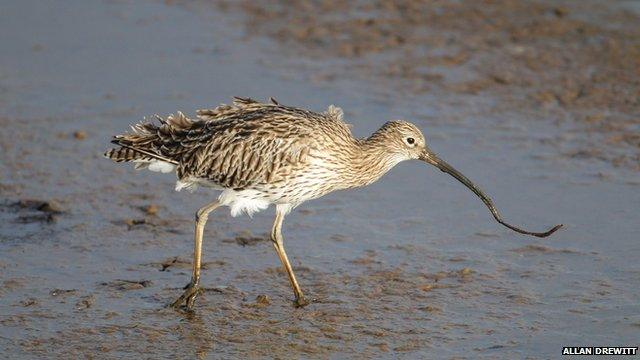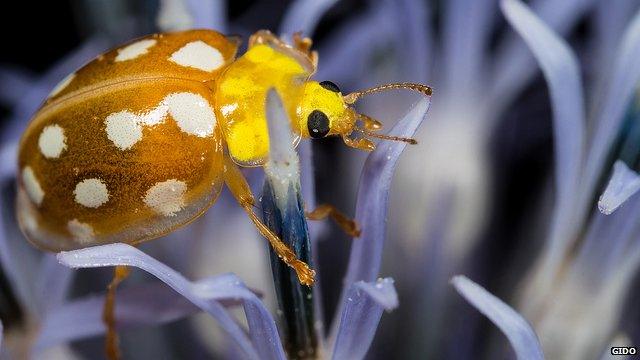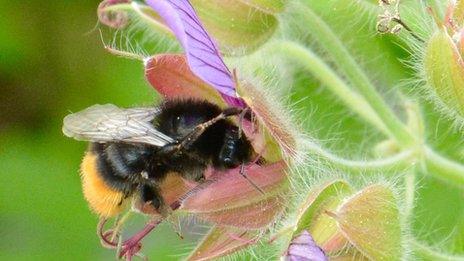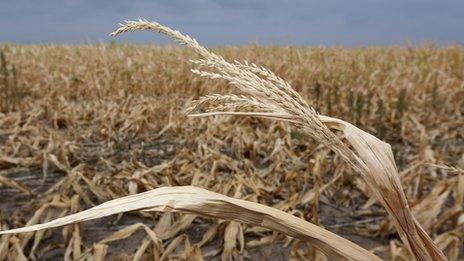Growing threat to England's curlews from climate change
- Published

The curlew is likely to feel the impacts of warming in England
Much-loved birds including curlews and cuckoos are under a growing threat from climate change in England, according to a new report.
Other species including golden plovers and lapwings are also at risk from rising temperatures in the coming decades.
The report says changing conditions in England will significantly benefit wasps, ants and many southern species.
The study, external is said to be the largest of its kind ever undertaken in England.
Researchers looked at the impacts of a 2 degrees C rise in global average temperatures on over 3,000 species. They projected where the most suitable ranges for these plants and animals would be found in 2080.
When the researchers looked in more detail at 155 species listed as being of high conservation concern, 38% were identified as being at risk with 39% potentially benefitting from warmer temperatures.
"The positive side of things is kind of painting maybe too rosy a glow, because many species may not get there," Dr Humphrey Crick from Natural England told BBC News.

The orange lady bird is also expected to struggle in a warmer England
"Some species will be pushed further and further north and some may end up in Scandinavia rather than in Britain at all."
Many of those at risk are found in the north and in upland areas, but there are also lowland species under threat including rare spring sedge, orange ladybirds and triangle hammock spiders.
For species like the curlew, the climate impacts are mostly to do with water.
"In the upland areas it's the drying out of the habitats and the lack of rainfall that might occur and the increased evaporation, and the habitats that many of these northern species will dry out - for things like curlew the ground will be too hard for them, to stick their beak in effectively," said Dr Crick.
The report paints a picture of a divided England. Species such as wasps, bees and ants, are likely to do better in warmer conditions and move into newer habitats.
Some birds are also set to thrive including the avocet and the little egret. Some are already doing so, including the Dartford warbler which was reduced to just a few pairs in the 1960s. It recovered and has moved across England in recent years, thanks to a changing climate.

Cuckoo numbers have dropped significantly in the past 20 years
"They have spread quite widely, up into Surrey, up into Suffolk, the Peak District and into Wales," said Dr Crick.
"They have done incredibly well, and we can pretty well ascribe those changes to climate, and the less severe winters we have had. They could become a characteristic species of the uplands in the future."
The authors of the report believe the document will be a useful guide for land managers across England on how to prepare the ground for the arrival of new species in the decades to come.
Other experts believe it's an important signpost for the future.
"This report builds upon a substantial weight of evidence that climate change is already affecting UK species, and will have further, large impacts in the future," said Dr Richard Bradbury, from the RSPB.
"The nature we know and love will change, with some warmth-loving species becoming more familiar, while we risk saying goodbye to some of England's colder-adapted species."
"It is imperative that we minimise the risks, by reducing carbon emissions, while redoubling our efforts to reduce the threats to vulnerable species and provide safe homes for nature, both in nature reserves and other protected areas, and in the wider landscapes in which wildlife should thrive."
The report has been published by Natural England in partnership with the British Trust for Ornithology, University of York, the Centre for Ecology and Hydrology and the RSPB.
Follow Matt on Twitter @mattmcgrathbbc, external.
- Published9 July 2015

- Published8 July 2015

- Published14 July 2015
